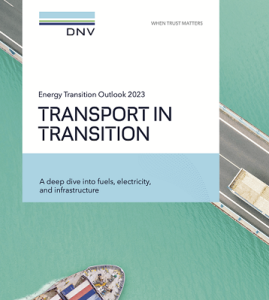DNV Transportation Emission Report: A Deep Dive into the Future of Global CO2 Emissions

Alarmingly, the report predicts a significant rise in the transportation sector’s share of global energy-related carbon dioxide emissions – from roughly 25 percent today to an unsettling 30 percent by 2050.
DNV, a globally recognized assurance and risk management company based in Oslo, Norway, has recently published a comprehensive report titled “Transport in Transition.” This document, also known as DNV Transportation Emission Report, provides a detailed projection of the future of energy consumption in the transportation sector, which is currently lagging behind other sectors in minimizing CO2 emissions.
Alarmingly, the report predicts a significant rise in the transportation sector’s share of global energy-related carbon dioxide emissions – from roughly 25 percent today to an unsettling 30 percent by 2050.
DNV Transportation Emission Report Forecasts a Surge in Electricity-powered Transport

From its current contribution of a mere 1 percent, electricity’s share is expected to skyrocket to a significant 23 percent.
According to DNV transportation emission report by mid-century, electricity is set to play a much more prominent role in powering transport across the globe. From its current contribution of a mere 1 percent, electricity’s share is expected to skyrocket to a significant 23 percent. This dramatic increase is primarily due to the strides being made in the efficiency of electrified road transport, which is fast reducing the transport sector’s heavy reliance on fossil fuels.
Enjoying our insights?
Subscribe to our newsletter to keep up with the latest industry trends and developments.
Stay Informed
Aviation Sector’s Prolonged Battle with Biofuels
DNV transportation emission report presents a different picture for the aviation sector. Contrary to the progress seen in road transport, the aviation sector foresees a somewhat stagnant future in terms of changing its energy sources. DNV’s report forecasts that oil consumption within aviation will remain virtually flat until 2050, with hydrocarbons continuing to hold a dominant 60 percent share in the sector.
DNV’s report forecasts that oil consumption within aviation will remain virtually flat until 2050, with hydrocarbons continuing to hold a dominant 60 percent share in the sector.
The report also suggests that advanced biofuels, despite their sustainability, are expected to fulfill only 25 percent of aviation’s energy demand, primarily due to their higher cost and the fierce competition for sustainable feedstock.
Navigating the Energy Transition in the Maritime Sector
The maritime sector, under the compulsion to decarbonize, is expected to undergo a significant transition in its energy consumption. By 2050, it is predicted that this sector will shift from being almost entirely dependent on oil to a diversified energy mix. This mix will comprise 50-percent low and zero-carbon fuels, 19 percent natural gas, and 18 percent biomass. However, the DNV transportation emission report emphasizes that this transition will require substantial support from both governmental bodies and the industry to manage the burgeoning demand for advanced biofuels in maritime transport.

By 2050, it is predicted that the maritime sector will shift from being almost entirely dependent on oil to a diversified energy mix.
The Uphill Battle for Biofuels: Challenges and Future Scope
The DNV report identifies sustainability as the primary challenge in expanding the use of biofuels. The report notes the “intense competition for sustainable feedstock for advanced biofuels for aviation and shipping” and predicts that electricity will displace first-generation biofuels in road transport.
Despite these challenges, the report sees a significant role for biofuels in the future, driven by stringent regulations and increasing consumer demand for sustainable energy solutions.
Hydrogen in Transportation: A Future Fuel?

By 2050, battery electric vehicles are predicted to make up a staggering 78 percent of the global fleet.
DNV transportation emission report also delves into the future role of hydrogen in transportation. Given the energy-intensive nature of hydrogen production, it is expected that hydrogen will scale into the aviation and maritime segments only from the mid-2030s. For long-distance shipping, which has limited decarbonization options, hydrogen-based fuels like ammonia and methanol could represent a significant 50% of the maritime fuel mix by 2050.
Battery Electric Vehicles: The Vanguard of Decarbonization
DNV transportation emission report highlights that Europe, North America, and China are at the forefront in the adoption of battery electric vehicles. These regions are not only leading in terms of the adoption rate but are also making considerable investments in hydrogen and hydrogen-based fuels. These energy sources are viewed as the most promising options for moving heavy goods over long distances. By 2050, battery electric vehicles are predicted to make up a staggering 78 percent of the global fleet.
Renewable Energy in Transport: The Road Ahead

The DNV report identifies sustainability as the primary challenge in expanding the use of biofuels.
However, the DNV transportation emission report also points out that regions such as sub-Saharan Africa and Northeast Eurasia are still a considerable distance from establishing the necessary infrastructure and producing the quantities of renewable electricity required to decarbonize road transport. This observation underscores the necessity of global cooperation and local efforts to accelerate the adoption of sustainable energy.
Conclusion: Navigating the Road to a Sustainable Future
In conclusion, DNV transportation emission report serves as a stark reminder of the urgent need for the transportation sector to speed up its transition to sustainable energy. As the world grapples with the growing threat of climate change, this report offers critical insights into the complex challenges and potential opportunities that lie ahead. It emphasizes the importance of concerted efforts from governments, industry, and consumers to drive the change required to create a sustainable future for all. As we navigate this transition, every step we take brings us closer to our shared goal of reducing global CO2 emissions and protecting our planet.
Learn More About Related Issues:
- Discover the strategic shift in Nikola EV production: Gain insights into the strategic shift in the Nikola EV production pause to focus on a build-to-order model, a stake sale in Europe, and a focus on hydrogen fuel cell technology
- US Foods Electric Trucks: Learn about US Foods’ strategic move towards sustainability with the incorporation of electric trucks in their transportation fleet.
- Half of Trucks Could Become Electric: Explore the future scenario of the transportation industry with the potential shift of half of all trucks towards electric power.
- EPA Truck Emission Rule Strongest Ever: Understand the environmental implications of EPA’s latest and stringent truck emission rules that are considered the strongest ever.
- EU Heavy Vehicle Emissions Deadline: Get informed about the European Union’s deadline set for heavy vehicle emissions, marking a significant step towards climate goals.
- US Funds EV Charging Infrastructure: Discover the US government’s financial support for the expansion of the electric vehicle charging infrastructure across the country.
- Fleet Challenges and Strategies in 2023: Delve into the complex world of fleet management in 2023, exploring the contemporary challenges and strategic solutions.
Explore Industry Resources and Insights:
- Transport in Transition DNV – This report by DNV discusses how the shipping, aviation, and road transport sectors contribute to global emissions, and forecasts future trends.
- Are aviation biofuels ready for take off? – IEA – This International Energy Agency (IEA) commentary discusses the potential of aviation biofuels to reduce the industry’s carbon emissions.
- Hydrogen’s Role in Transportation – Department of Energy – This page from the U.S. Department of Energy discusses the role of hydrogen fuel in reducing transportation emissions and its advantages in powering vehicles.
- DNV GL – Maritime – This is the maritime section of the DNV GL website, a leading provider of risk management and quality assurance services to the maritime, oil and gas, and power and renewables industries.
- International Energy Agency – Transportation – This is the transportation section of the IEA website, which provides data, forecasts and policy advice on the role of transport in energy transitions.



















